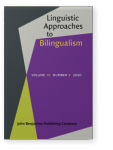Squib
Comment Clauses and mood choice in New York City Spanish
Generational constraints and innovations
This paper focuses on Spanish grammatical mood variation in Comment Clauses (e.g., es mejor que no
vayas (subjunctive) / vas (indicative) ‘it’s better you not go’) in the speech of two generations in
New York City. The data come from 36 participants, 18 from each of two generational cohorts. Carried out within the
variationist-sociolinguistic research paradigm, we test grammatical mood against eight variables, four external (generation,
region, speaker sex, language skill) and four internal (grammatical tense, clause type, lexical identity, negation). Statistical
findings reveal that generation significantly conditions subjunctive use (the first generation has a significantly higher rate of
use of subjunctive forms than does the second generation); English skill conditions first-generation subjunctive use (those with
‘good or excellent’ English skills have a higher subjunctive rate than those with ‘fair or poor’ English skills); clause type
conditions both generations’ subjunctive use (impersonal constructions yield a higher subjunctive rate than personal
constructions); lexical identity and negation in the matrix clause both condition first-generation use of mood
(gustar ‘to like’ favors the indicative; importar ‘to be important’ and ser
+ impersonal expression ‘to be’ both favor the subjunctive). Generational differences are thus observed with respect to both
social and linguistic conditioning factors.
Article outline
- 1.Introduction
- 2.Methodology
- 3.Findings and discussion
- 4.Concluding remarks
- Notes
-
References
References
Acevedo, R.
(
2000)
Perspectiva histórica del paradigma verbal en el español de California. In
A. Roca (Ed.),
Research on Spanish in the United States: Linguistic Issues and Challenges (pp. 110–120). Somerville: Cascadilla Press.

Fábregas, A.
(
2014)
A guide to subjunctive and modals in Spanish: Questions and analyses.
Borealis: An International Journal of Hispanic Linguistics, 3(2), 1–94.


Gragera, A.
(
2002)
LI attrition and L2 acquisition of Spanish subjunctive. A functionalist approach. Valladolid: Universitas Castellae.

Guitart, J.
(
1982)
On the use of the Subjunctive among Spanish-English bilinguals.
Word, 331, 59–67.


Gutiérrez, M.
(
2003)
Simplification and innovation in U.S. Spanish.
Multilingua, 221, 169–84.


Lantolf, J.
(
1978)
The variable constraints on mood in Puerto Rican-American Spanish. In
M. Suñer (Ed.),
Contemporary studies in Romance linguistics, (pp. 193–217). Washington DC: Georgetown University Press.

Lynch, A.
(
1999)
The subjunctive in Miami Cuban Spanish: Bilingualism, contact, and language variability (Unpublished doctoral dissertation). University of Minnesota, Minnesota.

Montrul, S.
(
2009)
Knowledge of tense-aspect and mood in Spanish heritage speakers.
International Journal of Bilingualism, 13(2), 239–69.


Ocampo, F.
(
1990)
El subjuntivo en tres generaciones de hablantes bilingües. In
J. Bergen (Ed.),
Spanish in the United States: Sociolinguistic issues (pp. 39–48). Washington DC: Georgetown University Press.

Otheguy, R., & Zentella, A. C.
(
2012)
Spanish in New York: Language contact, dialectal leveling and structural continuity. Oxford: Oxford University Press.


Otheguy, R., & Lapidus, N.
(
2005)
Matización de la teoría de la simplificación en las lenguas en contacto: El concepto de la adaptación en el español de Nueva York. In
O. López &
M. Lacorte (Eds.),
Contactos y contextos lingüísticos: El español en los Estados Unidos y en contacto con otras lenguas (pp. 143–160). Madrid/Frankfurt: Iberoamericana/Vervuert.

Poplack, S., Torres Cacoullos, R., Dion, N., de Andrade Berlinck, R., Digesto, S., LaCasse, D. & Steuck, J.
(
2018)
Variation and grammaticalization in Romance: A cross-linguistic study of the subjunctive. In
W. Ayres-Bennett &
J. Carruthers (Eds.),
Manual in Linguistics: Romance Sociolinguistics 18 (pp. 217–252). Berlin: De Gruyter.

Shin, N.
(
2014)
Grammatical complexification in Spanish in New York: 3sg pronoun expression and verbal ambiguity.
Language Variation and Change, 26(3), 303–330.


Silva-Corvalán, C.
(
1994)
The gradual loss of mood distinctions in Los Angeles Spanish.
Language Variation and Change, 61, 255–72.


Torres, L.
(
1989)
Mood selection among New York Puerto Ricans.
International Journal of the Sociology of Language. Special issue in
I. Wherritt &
O. Garcia (Eds.),
U.S. Spanish: The Language of Latinos, 791, 67–77.

Viner, K. M.
(
2017)
Subjunctive Use in the Speech of New York City Spanish Heritage Language Bilinguals: A Variationist Analysis.
Heritage Language Journal, 14(3), 307–333.


Viner, K. M.
(
2018a)
The Optional Spanish Subjunctive Mood Grammar of New York City Heritage Bilinguals.
Lingua, 210–2111, 79–94.


Viner, K. M.
(
2018b)
Conditional Morphology in New York Heritage Spanish: General and Variable Usage.
Studies in Hispanic and Lusophone Linguistics, 11(2), 429–457.


Cited by
Cited by 1 other publications
Viner, Kevin Martillo
2021.
Generational differences in the placement of clitic se in New York City Spanish.
International Journal of Bilingualism 25:5
► pp. 1460 ff.

This list is based on CrossRef data as of 23 april 2022. Please note that it may not be complete. Sources presented here have been supplied by the respective publishers.
Any errors therein should be reported to them.
